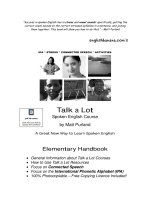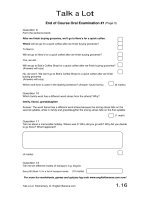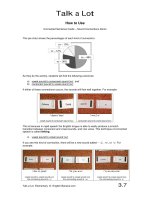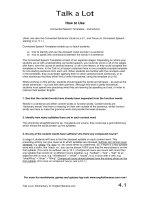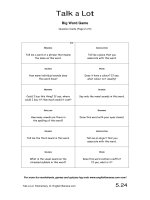Tài liệu Spoken english elementary handbook part 2 docx
Bạn đang xem bản rút gọn của tài liệu. Xem và tải ngay bản đầy đủ của tài liệu tại đây (189.01 KB, 15 trang )
Talk a Lot
General Information
Plan of all Talk a Lot Units and Activities
For more fun worksheets, games and quizzes log onto www.englishbanana.com now!
Talk a Lot Elementary © English Banana.com
1.1
This page shows all of the units and activities from the first three Talk a Lot Elementary books.
A
3
indicates that the material for this activity has been published and can be found online at:
Note: we hope to update this page regularly, as more material
is added to each Talk a Lot unit! (Page last updated 08/2009)
Sentence Focus Word Focus Free Practice Tests
Unit / Activity
SBs CCs CTs DWs DWQs IEs MPTs DQs AGs RPs VTs LTs
How to Use
3
3
3
3
3
3
3
3
3
3
3
3
Elementary Book 1:
1 Town
3
3
3
3
3
3
3
2 Food and Drink
3
3
3
3
3
3
3
3 Shopping
3
3
3
3
3
3
3
4 Health
3
3
3
3
3
3
3
5 Transport
3
3
3
3
3
3
3
6 Family
3
3
3
3
3
3
3
7 Clothes
3
3
3
3
3
3
3
8 Work
3
3
3
3
3
3
3
9 Home
3
3
3
3
3
3
3
10 Free Time
3
3
3
3
3
3
3
Elementary Book 2:
1 Crime
3
3
3
3
3
3
3
2 Sport
3
3
3
3
3
3
3
3 Music
3
3
3
3
3
3
3
4 Weather
3
3
3
3
3
3
3
5 Animals
3
3
3
3
3
3
3
6 Cars
3
3
3
3
3
3
3
7 The Human Body
3
3
3
3
3
3
3
8 Colours and Numbers
3
3
3
3
3
3
3
9 Life Events
3
3
3
3
3
3
3
10 Nature
3
3
3
3
3
3
3
Elementary Book 3:
1 Learning English
3
3
3
3
3
3
3
3
3
3
3
3
2 Films
3
3
3
3
3
3
3
3
3
3
3
3
3 Hospital
3
3
3
3
3
3
3
3
3
3
3
3
4 Books
3
3
3
3
3
3
3
3
3
3
3
3
5 Airport
6 Television
7 Education
8 Money
3
3
3
3
3
3
3
3
3
3
3
3
9 The Environment
10 Holidays
KEY
Sentence Focus Activities: SBs (Sentence Blocks); CCs (Connected Sentence Cards);
CTs (Connected Speech Templates)
Word Focus Activities: DWs (Discussion Words); DWQs (Discussion Word Questions);
IEs (Information Exchanges); MPTs (Multi-Purpose Texts)
Free Practice Activities: DQs (Discussion Questions); AGs (Agree or Disagree?);
RPs (Role Plays)
Tests: VTs (Vocabulary Tests); LTs (Lesson Tests)
Talk a Lot
General Information
Course Outline
For more fun worksheets, games and quizzes log onto www.englishbanana.com now!
Talk a Lot Elementary © English Banana.com
1.2
• Before the course begins perform an initial assessment with each student to check
that they are at a suitable level for the course, and then enrol them onto the course.
This course is aimed at students who are at a good elementary level or pre-
intermediate level. For this course we recommend that there are no more than ten
students per class.
• Before we start, the Talk a Lot course materials are designed to be flexible, and can
be used in any way that you find suitable for your group or your needs. The course
outline below is just an example, so please don’t feel that you have to follow it to the
letter!
• The course is divided into twelve three-hour lessons. The first ten lessons each have
a different topic; while lesson 11 is intended for the revision of material studied over
the ten weeks, and lesson 12 is reserved for the students’ examinations and an end
of course review. We recommend that you hold one lesson per week, making this a
twelve week course comprising 30 guided learning hours, plus 6 hours of guided
revision and examination. It’s up to you what order you do the lessons in; you don’t
have to follow our order of topics!
• If your students need more than three hours of study per week, why not offer them
two 3-hour lessons per week: one Talk a Lot lesson, as described below, and one
lesson using traditional teaching methods, which include conventional reading, writing
and grammar-based activities that could complement the intensive speaking and
listening work of the Talk a Lot lessons. You could follow a standard EFL or ESL
course book such as New English File or New Headway, using material that
complements the Talk a Lot lesson, so, for example, if your Talk a Lot lesson was on
the topic of Sport, you could use material from a traditional course book on the same
topic for the second lesson. This would then give you a course with 60 guided
learning hours.
Talk a Lot
General Information
Lesson Outline
For more fun worksheets, games and quizzes log onto www.englishbanana.com now!
Talk a Lot Elementary © English Banana.com
1.3
• In our example lesson outline, each lesson lasts for three hours (180 teaching
minutes). This can vary according to your needs, for example, in some English
language classrooms one teaching hour is equal to 45 minutes, and so 3 teaching
hours would be 2¼ hours. Or it may be that you have only 2 hours per week with your
group of students. You can still use Talk a Lot activities to serve up a satisfying and
stimulating lesson – just in a shorter timeframe.
• Each lesson focuses on a specific vocabulary topic. Books 1 and 2 each contain ten
different topics, and Book 3 will also have 10 new topics. Book 3 also introduces
several brand new activities – e.g. Multi-Purpose Texts – so that teachers now have
an even greater variety of possible things to do in each lesson. For each lesson the
teacher can now draw from twelve different activities in four practice categories:
Sentence Focus Activities:
• Sentence Blocks (C)
• Connected Sentence Cards
• Connected Speech Templates
Word Focus Activities:
• Discussion Words and Question Sheets
• Information Exchange
• Multi-Purpose Texts
Free Practice Activities:
• Discussion Questions
• Agree or Disagree?
• Role Plays
• Show and Tell (C)
Continuous Assessment Tests:
• Vocabulary Test (C)
• Lesson Test (C)
The activities marked with (C) are, we believe, core activities that should be included
in every Talk a Lot lesson. Of course, it’s up to you whether you want to do this!
However, it is not necessary to use every activity in every lesson. There is far more
material in each Talk a Lot unit than is needed to fill three hours of lesson time, so the
teacher can mix and match, using different activities from different practice categories
in different lessons, according to the needs of their learners. Similarly, it is not
necessary to do the activities in the same order (as stated below) in every lesson, but
better to mix things up each time so that students don’t become used to a set lesson
order.
The core activities provide a reassuring routine for each lesson. For example, at the
beginning of each lesson students come together for the Vocabulary Test and
Talk a Lot
General Information
Lesson Outline
For more fun worksheets, games and quizzes log onto www.englishbanana.com now!
Talk a Lot Elementary © English Banana.com
1.4
Show and Tell, and at the end of the lesson for Q & A time, and a preview of the next
lesson’s topic.
• Bearing that in mind, here is an example of how you could structure a 3-hour long
Talk a Lot lesson:
15 mins Welcome and Vocabulary Test (see p.1.7) based on the previous lesson’s
topic. The teacher reads out the twenty words to the students in their native
language and they write them in English. The teacher gives back lesson
tests, discusses the answers with the students, and can also ask random
questions from the previous lesson’s sentence blocks to check how much the
students have remembered.
15 mins The teacher introduces the topic of this lesson, for example, “Music”. Each
student has to Show and Tell an item to do with this topic, e.g. for “Music” a
student could bring a musical instrument, or a CD or poster, and then tell the
class about it. This free practice activity is an easy warm-up for students, and
a way into the lesson topic. The teacher also brings something to “show and
tell”, and then introduces the eight new Sentence Block starting sentences
and wh- questions on the board or on the handout (see p.2.1). It is essential
that the teacher checks that the students understand the sentences, so that
they are meaningful to students when they practise them later on.
The teacher asks different students to model one or two of the sentence
blocks, which will act as a reminder to students of how to make the sentence
blocks.
20 mins Students make the sentence blocks in pairs, for example, sitting back to back
without eye contact. They don’t write anything down and must not copy the
sentence block starting sentences from the board. For this activity all the talk
flows from the students making the sentence blocks from the starting
sentences and wh- questions on the board or on the handout.
10 mins Next, the teacher introduces the eight Discussion Questions for this lesson
to the whole class (see p.8.1). Again, it is important that the teacher checks
that their students understand the vocabulary that is used. Students should
be encouraged to use their dictionaries to check new words.
30 mins Working in pairs or small groups, students practise the discussion questions.
This is free speaking practice – the antithesis of having to make pre-set
sentences using the sentence blocks. The students can change partners
several times in order to get a good variety of practice, then the whole class
comes together and feeds back to the group, with the teacher asking
additional follow-up questions. During this time the teacher removes the
sentence block sentences from the board, or asks the students to return their
sentence block handouts. This free practice session could be equally
effective with the Agree or Disagree? activity (see p.9.1), or Role Plays
C. A. Tests
CORE
Free Practice
CORE
Sentence Focus
CORE
Free Practice
Talk a Lot
General Information
Lesson Outline
For more fun worksheets, games and quizzes log onto www.englishbanana.com now!
Talk a Lot Elementary © English Banana.com
1.5
(see p.10.1), instead of the Discussion Questions. You could vary what your
students do lesson by lesson.
We’re halfway through! Have a cup of tea and some fresh air – or just hang out!
25 mins After a relaxing break it’s time for some brain work – the Lesson Test (see
page 1.8)! The aim of this test is for the teacher to find out what vocabulary
the students can remember from the previous lesson and to get an idea of
how well they are coping with making the sentence blocks.
25 mins The next section is for word focus activities. The teacher could decide to use
this slot for activities with the Discussion Words and Question Sheets (see
p.5.1), for doing the Information Exchange (see p.6.1), or for working with
the Multi-Purpose Texts (see p.7.1) – or you could base an activity on our
handouts about word stress, suffixes, or compound nouns, etc. (see from
p.11.1). Students could do a couple of different activities within the time
allowed, depending on their level.
30 mins The students practise the sentence block sentences again, but this time
without any written record – nothing on the board and no handout. The
teacher monitors each pair and helps them where necessary, making sure
that they are making the sentence blocks successfully. Towards the end of
this time the whole class comes back together to give each other feedback.
The teacher asks questions from the eight sentence blocks to different
students, who should give a correct, or nearly correct, sentence – all from
memory. In the early weeks this will be more difficult for the students, but
after a few lessons with this method students should be able to answer
confidently, having memorised some or all of that lesson’s sentence blocks.
This section could be used for practising connected speech techniques, using
either the Connected Sentence Cards (see p.3.1) or Connected Speech
Templates (see p.4.1) – or both, if your students are really “getting it”!
Another alternative would be to do an activity about sentence stress, using
some of the material that starts on p.12.1.
10 mins Open question time – students can ask any English-related question. The
teacher looks at the students’ workbooks (this can be any suitable course
book that students work through at home and which complements the lesson)
and checks students’ progress. The teacher previews the topic for the next
lesson and gives out the handouts for the next lesson’s vocabulary test. The
teacher could either give or spend a few minutes eliciting the twenty new
words in the students’ first language. The teacher should encourage students
to keep all of their handouts in their own file, for revision and further study at
home.
C. A. Tests
CORE
Word Focus
Sentence Focus
Free Practice
CORE
Talk a Lot
General Information
Assessment Methods, Tests, and Examination
For more fun worksheets, games and quizzes log onto www.englishbanana.com now!
Talk a Lot Elementary © English Banana.com
1.6
The overall course mark for each student is reached by continuous assessment and an end of
course oral examination. Individual students are monitored throughout the course and their
progress recorded in a number of different ways. The aim of using continuous assessment is
to encourage students to work hard in every lesson – because every lesson counts and effort
is rewarded along with accuracy – and to work hard at home, e.g. learning the vocabulary
words each week.
Each student gets a combined mark out of 80 for each lesson which is based on the following:
• vocabulary test: maximum of 20 marks
• lesson test: maximum of 40 marks
• student’s lesson mark – accuracy: maximum of 10 marks
• student’s lesson mark – effort: maximum of 10 marks
• total lesson mark: maximum of 80 marks
The lesson marks are added together on the individual Student Course Reports as the course
progresses (see p.1.12 for a sample completed report, and p.1.11 for a blank template).
Students don’t have access to their lesson marks as they are added together, but they do see
their marks for the vocabulary and lesson tests, as well as getting feedback on these tests
and on their general performance each week.
Teachers should award marks out of 10 to each student for every lesson based on the level of
their achievement during the lesson (accuracy) and their commitment during the lesson
(effort). It goes without saying that teachers should strive to be wholly objective and not give
in to favouritism when awarding these marks.
Over the ten lessons all of the lesson marks are added together to give an individual total for
each student, to which is added the score from their final exam. This gives each student a
grade for the whole course, ranging from A to U (ungraded fail):
• maximum lesson mark of 80 x 10 = 800 marks +
• maximum final exam mark of 100 =
• maximum course mark of 900 marks
Grade system: Achievement:
Grade A = 800-900 marks First Class
Grade B = 650-800 marks Very Good
Grade C = 550-650 marks Good
Grade D = 400-550 marks Fair Pass
Grade E = 250-400 marks Pass
Grade U = less than 250 marks Fail
Grades A-E are passes. Grade U is ungraded and means that the student has failed the
course. The student’s grade is recorded on their course certificate, for example:


